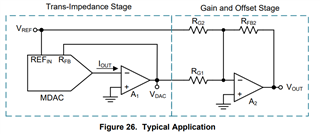Other Parts Discussed in Thread: OPA2192
Tool/software:
Hi,
Currently, one of my customers is using a DAC8811I in an analog signal control circuit, and has noticed a phenomenon in which sudden noise (approximately 300nV) occurs intermittently at the output (Vout).
■ Circuit Configuration
The circuit is based on Figure 26 in the DAC8811 datasheet, with the following component values and specifications:
| Item | Part Number | Specification | ||
|---|---|---|---|---|
| DAC | DAC8811IBDGKT | VDD = 3.3 V, GND = 0 V | ||
| Trans-impedance amplifier | OPA2209AIDGKT | V+ = +15 V, V− = −15 V | ||
| Gain & offset stage amplifier | OPA2209AIDGKT | V+ = +15 V, V− = −15 V | ||
| R_G1 | - | 2 kΩ | ||
| R_G2 | - | 2 kΩ | ||
| R_REF2 | - | 2 kΩ | ||
| Input (VREF) | - | Sine wave, Vout = ±5 V (1 V/div), f = 8.2 kHz |
■ Description of the Noise Phenomenon
-
Phenomenon: The noise appears as a deviation between Vout and VREF, up to approximately 300 nV.
-
Waveform: Resembles either a rectangular or jittery noise burst, occurring at random intervals. In some cases, it disappears after some time.
-
Frequency dependency and triggering conditions remain unclear.

■ Our Internal Analysis (Possible Causes)
We have considered the following possibilities on our side:
-
Ground loop between digital and analog grounds
-
Glitch current from the DAC output (Iout) during code updates
-
External noise coupling (e.g., EMI, ESD)
-
Ripple or transient disturbances from ±15 V power supplies
-
Potential instability at the MDAC output load (A1 input)
Could you please advise us whether such a noise phenomenon could be expected in this configuration, and if so, what countermeasures or design adjustments you would recommend?
Best regards,
Conor

